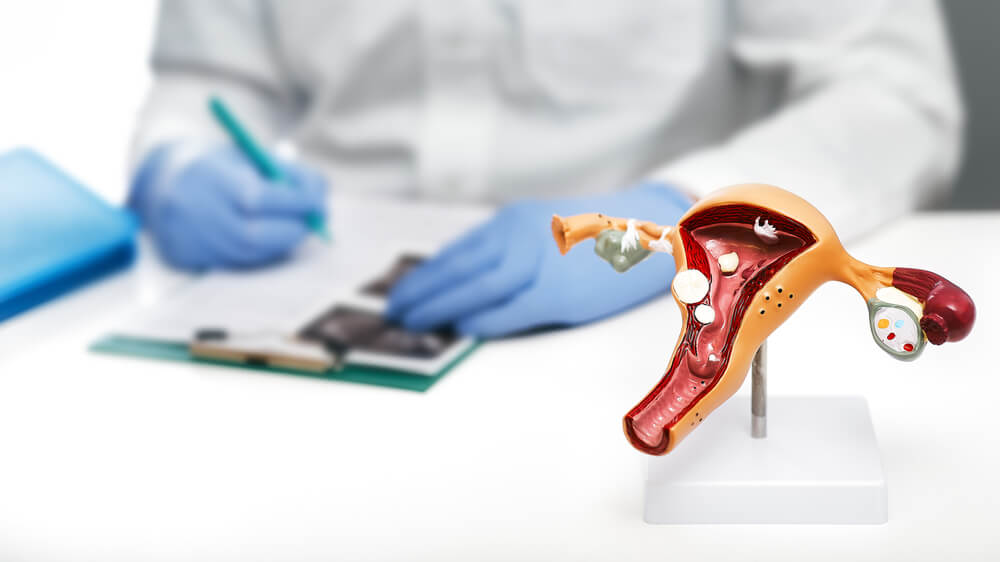Uterine polyps, also known as endometrial polyps, are growths that develop on the inner lining of the uterus. They are commonly found in women of reproductive age, and while they are usually benign, they can cause a range of symptoms and issues. In this article, we will examine the symptoms of uterine polyps, the potential causes, and the available treatment options. Understanding the symptoms, causes, and treatments of uterine polyps can help women take an informed and proactive approach to their health and well-being. That said, it’s essential to have a thorough gynecological exam at least once a year, if not more frequently, to maintain good reproductive health.
What Are Uterine Polyps?
Uterine polyps are growths that develop on the inner lining of the uterus. They are typically made up of glandular tissue and stroma, which are the same tissues that make up the endometrium, the lining of the uterus. Uterine polyps can vary in size, ranging from a few millimeters to several centimeters in diameter. The exact cause of uterine polyps is poorly understood, but they have been linked to hormonal imbalances, especially high estrogen levels. They may also be caused by genetic factors or due to previous medical conditions or treatments, such as infertility or hormone therapy.
Uterine polyps are generally not cancerous but can cause irregular or heavy menstrual bleeding, prolonged menstrual periods, and spotting between periods. They can also cause pain during intercourse, pelvic pain, and infertility in some cases. Women with uterine polyps may also experience infertility, which can be due to the polyps blocking the fallopian tubes or preventing the implantation of a fertilized egg. In very rare cases, a uterine polyp may become cancerous, so it is crucial to seek prompt medical attention if you experience any symptoms. Overall, uterine polyps are relatively common and can usually be treated effectively with medication, surgery, or a combination of both.
Who’s at the Highest Risk of Uterine Polyps?

Uterine polyps most commonly affect women of reproductive age, typically between 40 and 60. However, they can occur at any age and affect women who have gone through menopause as well. Women who are overweight or obese are also more likely to develop uterine polyps, as obesity has been linked to hormonal imbalances and increased levels of estrogen, which can contribute to the growth of uterine polyps. Women with a history of infertility or who have undergone hormonal therapy, such as hormone replacement therapy or oral contraceptives, may also be at an increased risk of developing uterine polyps.
In addition to these risk factors, there may also be a genetic component to the development of uterine polyps. Women with a family history of uterine polyps may be more likely to develop them themselves. Furthermore, women with a history of uterine fibroids or benign tumors in the uterus may also be at an increased risk for developing polyps.
It is important to note that many women with uterine polyps may not experience any symptoms, and the polyps may be discovered during a routine gynecological exam. However, for women who experience uterine polyps symptoms, prompt diagnosis and treatment are crucial to prevent potential complications and maintain reproductive health.
Common Uterine Polyps Symptoms
Uterine polyps can cause various symptoms, but many women with uterine polyps may not experience any symptoms at all. The symptoms of uterine polyps can vary depending on the size and location of the polyps, as well as the underlying cause. Some common uterine polyps symptoms include:
- Irregular or heavy menstrual bleeding: Women with uterine polyps may experience longer or heavier menstrual periods, or they may experience spotting or bleeding between periods.
- Prolonged menstrual periods: Polyps can cause menstrual periods to last longer than usual.
- Pain during intercourse: Uterine polyps can cause discomfort or pain during sexual intercourse.
- Pelvic pain: Some women with uterine polyps may experience pelvic pain or discomfort.
- Infertility: In some cases, uterine polyps can cause infertility by blocking the fallopian tubes or impeding the implantation of a fertilized egg.
Other conditions can also cause these symptoms, so it is vital to seek medical attention if you experience any unusual changes in your menstrual cycle or pelvic health. Your healthcare provider can perform a physical exam and diagnostic tests, such as an ultrasound, to determine the underlying cause of your symptoms and provide an accurate diagnosis.
How Do Uterine Polyps Get Diagnosed?
Uterine polyps are usually diagnosed through a combination of physical examination, diagnostic imaging, and laboratory testing. The first step in diagnosing uterine polyps is typically a pelvic exam, during which your healthcare provider will feel for any abnormalities in your uterus. If a polyp is suspected, your healthcare provider may perform additional diagnostic tests to confirm the diagnosis and determine the size, location, and number of polyps present.
One common diagnostic tool is ultrasound, which uses high-frequency sound waves to produce images of your reproductive organs. Ultrasound can accurately determine the size and location of uterine polyps and help distinguish them from other conditions, such as fibroids. Another diagnostic tool is hysteroscopy, which involves inserting a lighted, slender instrument into the uterus to visualize the inside and obtain tissue samples for biopsy.
In some cases, your healthcare provider may also perform an endometrial biopsy, which involves obtaining a sample of the endometrial tissue for laboratory analysis. This test can help determine if the polyp is cancerous or precancerous and can also provide information about the underlying causes of the polyp.
Overall, an accurate diagnosis of uterine polyps is crucial to determine the most appropriate treatment and prevent potential complications.
Typical Uterine Polyps Treatment Options
The treatment for uterine polyps depends on several factors, including the size, number, and location of the polyps and the underlying cause. Sometimes, small, asymptomatic polyps may not require treatment and may be monitored with regular pelvic exams and diagnostic tests.
Hormonal therapy, such as hormonal birth control or hormone replacement therapy, may be recommended for women with uterine polyps that are caused by hormonal imbalances. This type of therapy can help regulate hormonal levels and reduce the growth of polyps.
How to Remove Uterine Polyps

If a polyp is causing symptoms or is large, it may need removal. One common uterine polyps treatment option is a procedure called hysteroscopy. As mentioned, during this procedure, the doctor inserts a lighted, thin instrument into the uterus to visualize the inside of it and remove the polyp. This procedure can usually be performed on an outpatient basis and does not require an incision, making it a less invasive option for many women.
Sometimes, a polyp may be too large or deeply embedded to be removed with a hysteroscopy. In these cases, a surgical procedure called a myomectomy may be necessary to remove the polyp and preserve the uterus. This procedure involves making an incision in the uterus and removing the polyp, typically performed under general anesthesia.
Trust the Experts
Working closely with your healthcare provider to determine the best treatment option for your situation is a must. Your healthcare provider will consider several factors, including your overall health, symptoms, and the size and location of the polyps, in order to develop a personalized treatment plan that is safe and effective for you. Don’t hesitate to contact Dr. Andrew Krinsky in Tamarac, Florida, if you have any concerns or questions about your gynecological health.


